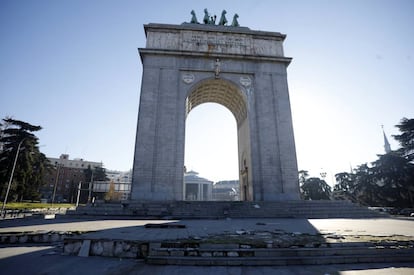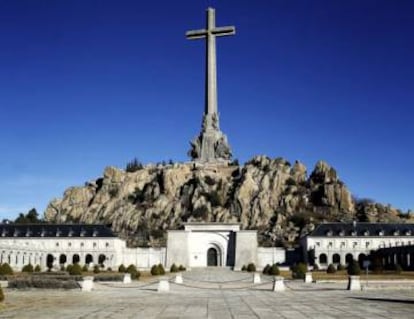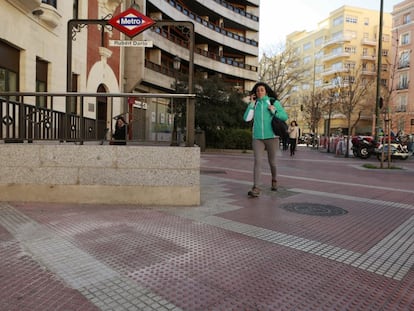What should Madrid do with its Franco-era victory arch?
Critics want the monument celebrating troops of former Spanish dictator torn down

On March 28, 1939, the right-wing forces of General Francisco Franco finally took control of Madrid after a dramatic siege lasting 28 months – a decisive move that effectively marked the end of a civil war in Spain that had cost the lives of around half-a-million people, and led to the installation of Franco as Spain’s dictator, a position he would hold until his death in 1975.
Now, 77 years on – and around four decades since the return of democracy to Spain – the triumphant entry of Franco's troops into Madrid is still marked in the form of the 43-meter high Victory Arch in the capital’s Moncloa district, a site chosen because of its proximity to the battlefront.
It is shameful the arch hasn’t bothered anyone in 40 years Emilio Silva, President ARMH
The monument, which was completed in 1956, was never officially inaugurated and has never been used as either a viewing point or an exhibition center – two of the purposes it was originally slated to fulfill. Instead, the archway exists as a constant reminder of a tragic period in Spanish history, and one that has been all but ignored by the authorities.
But this week the left-leaning political party Compromís, based in Spain’s Valencia region, asked the conservative Popular Party (PP) central government of Mariano Rajoy to tear down the monument, arguing it was an insult to the “memory of the victims of the military coup” that eventually brought Franco to power.
This is not the first time such a request has been made. In 2004, there was a request for the monument to be renamed the Harmony Arch while in 2010 the left-wing Izquierda Unida party demanded the removal of inscriptions honoring Franco’s victorious forces. The archway also features a Francoist coat of arms.
In a country where the legacy of Franco remains hotly contested, monuments associated with the fascist regime are highly controversial. In 2007, the Socialist government of former Prime Minister José Luis Rodríguez Zapatero passed the Historical Memory Law, which made provision for the removal of statues and the changing of place names connected to the Franco regime.
If they are going to change it, they could put up a skate ramp here Skaters at the Victory Arch
But there is a hitch. The law does not apply to monuments of architectural value, and this is the case with Madrid’s Victory Arch.
The monument is owned by a consortium charged with administering the assets of three universities: the Complutense University of Madrid, the Technical University of Madrid and Spain’s national distance learning university UNED. EL PAÍS tried to contact the administrators of the Victory Arch and find out their position on its future, but without success.
However, sources at Madrid City Hall told this newspaper that local authorities plan to include the monument in their historical memory plan for Madrid. At the same time, they hope to rebrand it – giving it a new significance – although the details are yet to be decided upon and would need to be approved by councilors.
Local historical memory associations agree about the need for change. “It is shameful that the arch hasn’t bothered anyone in 40 years,” says Emilio Silva, President of the Association for the Recuperation of Historical Memory.

“President and rectors have come and gone while this arch, which celebrates the victory of soldiers who carried out a military coup, is still there. It has to be reinterpreted in some way,” he adds.
This is an opinion shared by Arturo Peinado, President of the State Federation of Memory Groups: “It has to be given a new significance. It could be a homage to the defense of Madrid, like the defense arch in Paris.”
Recently a group of skaters huddled under the arch had this to say about the monument. “We don’t like what it stands for, but it protects us from the cold. If they are going to change it, they could put up a great skate ramp here.”
English version by George Mills.
Tu suscripción se está usando en otro dispositivo
¿Quieres añadir otro usuario a tu suscripción?
Si continúas leyendo en este dispositivo, no se podrá leer en el otro.
FlechaTu suscripción se está usando en otro dispositivo y solo puedes acceder a EL PAÍS desde un dispositivo a la vez.
Si quieres compartir tu cuenta, cambia tu suscripción a la modalidad Premium, así podrás añadir otro usuario. Cada uno accederá con su propia cuenta de email, lo que os permitirá personalizar vuestra experiencia en EL PAÍS.
¿Tienes una suscripción de empresa? Accede aquí para contratar más cuentas.
En el caso de no saber quién está usando tu cuenta, te recomendamos cambiar tu contraseña aquí.
Si decides continuar compartiendo tu cuenta, este mensaje se mostrará en tu dispositivo y en el de la otra persona que está usando tu cuenta de forma indefinida, afectando a tu experiencia de lectura. Puedes consultar aquí los términos y condiciones de la suscripción digital.
More information
Últimas noticias
Reinhard Genzel, Nobel laureate in physics: ‘One-minute videos will never give you the truth’
Pinochet’s victims grapple with José Antonio Kast’s rise in Chile
From digital curfews to blocking apps: How technology experts protect their children online
Why the price of coffee has skyrocketed: from Brazilian plantations to specialty coffee houses
Most viewed
- Pablo Escobar’s hippos: A serious environmental problem, 40 years on
- Why we lost the habit of sleeping in two segments and how that changed our sense of time
- Trump’s obsession with putting his name on everything is unprecedented in the United States
- Charles Dubouloz, mountaineering star, retires at 36 with a farewell tour inspired by Walter Bonatti
- The Florida Keys tourist paradise is besieged by immigration agents: ‘We’ve never seen anything like this’










































